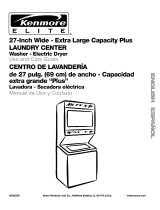
La lavadora no desagua ni exprime
&Est& obstruida ia manguera de desagLie, o est& el
extremo de ia manguera de desagLie a m&s de 96 puig.
(244 cm) por encima del piso? Vea las Instrucciones de
instalaci6n para la instalaci6n adecuada de la manguera de
desagOe.
&Est_ abierta la tapa? La tapa debe estar cerrada durante el
funcionamiento. La lavadora no agita ni exprime con la tapa
abierta.
&Hay demasiada espuma? Siempre mida el detergente.
Siga las indicaciones del fabricante. Si tiene agua muy suave,
quizas necesite usar menos detergente•
&Est& bajo el voltaje? Revise la fuente de electricidad de su
hogar o Ilame a un electricista• No use un cable electrico de
extensi6n.
La lavadora contin(=a Ilenando o desaguando, el ciclo
parece estar atascado
&Est& la parte superior de la manguera de desagLie m&s
baja que el nivel de agua en la lavadora? Para un
funcionamiento adecuado, la parle superior de la manguera
debe quedar mas alta que el nivel del agua en la lavadora.
Consulte las Instrucciones de instalaci6n.
&La manguera de desagLie encaja de manera forzada en
el tubo vertical o est& adherida con cinta al tubo vertical?
La manguera de desagL)e debe estar floja pero debe encajar
bien. No selle la manguera de desagOe con cinta adhesiva.
La manguera necesita una abertura para el flujo de aire.
Consulte las Instrucciones de instalaci6n•
La temperatura de lavado no es la que yo seleccion6
&Se han invertido las mangueras de entrada del agua
caliente y del agua fria? Para obtener mas informaci6n, vea
las Instrucciones de Instalaci6n. A medida que aumente la
frecuencia de lavado de las cargas, es posible que disminuya
la temperatura para las selecciones de temperatura de agua
caliente y tibia. Esto es normal•
Ropa demasiado mojada
• &Ha empleado el ciclo correcto para la carga que est&
lavando? Seleccione un ciclo con un exprimido m_.s fuerte (si
esta disponible).
• &Ha usado un enjuague con agua fria? Los enjuagues con
agua fria dejan las cargas mas mojadas que los enjuagues
con agua tibia. Esto es normal.
Residuos o pelusa en la ropa
• &Ha separado la ropa adecuadamente? Separe las
prendas que sueltan pelusa (toallas, felpilla) de las que atraen
peiusa (pana, articulos sinteticos)• Tambien separe por color.
&Ha sobrecargado la lavadora? La carga de lavado debe
estar equilibrada y sin sobrecarga. La ropa debe moverse con
libertad. Si la lavadora esta sobrecargada, la pelusa puede
quedar adherida alas prendas. Lave cargas m_.s pequeSas.
• &Ha seleccionado el nivel de agua correcto? El nivel de
agua debe ser el apropiado para el tamaSo de la carga. La
ropa debe moverse con libertad en el agua.
• &Ha usado suficiente detergente? Siga las indicaciones del
fabricante. Use suficiente detergente para mantener la pelusa
en el agua.
• &Ha secado la ropa en el tendedero? Si es asi, es posible
que quede algo de pelusa en la ropa.
• Verifique Io siguiente:
&Se dej6 papel o pafiuelo de papel en los bolsillos?
&Esta la temperatura del agua por debajo de 70°F (21°C)? El
agua de lavado con una temperatura inferior a 70°F (21°C)
puede que no disuelva por completo el detergente.
&Ha usado el tiempo del ciclo apropiado para la carga? Otra
manera de reducir la formaci6n de pelusa es reduciendo el
tiempo (la duraci6n) de lavado,
Manchas en la ropa
&Ha seguido las instrucciones del fabricante cuando
agreg6 el detergente y el suavizante de telas? Mida el
detergente y el suavizante de telas. Use suficiente detergente
para quitar la suciedad y mantenerla en suspensi6n. Diluya el
suavizante de telas y agreguelo solamente en la porci6n de
enjuague del ciclo. No deje escurrir el suavizante de tejidos
sobre la ropa.
• &Hay hierro (6xido) por encima del promedio comt_n en el
agua? Tal vez necesite instalar un filtro de 6xido ferroso.
• &Ha separado la ropa adecuadamente? Separe las
prendas de color oscuro de las blancas y claras.
• &Ha descargado la lavadora con rapidez? Para evitar la
transferencia de tintes, descargue la lavadora tan pronto
como se detenga.
La ropa est_ arrugada
• &Ha descargado la lavadora con rapidez? Descargue la
lavadora tan pronto como se detenga.
&Ha empleado el ciclo correcto para la carga que est&
lavando? Use el ciclo para ropa Informal o de Planchado
permanente, u otro ciclo con bajas velocidades de exprimido
(siesta disponible) para reducir arrugas.
• &Ha sobrecargado la iavadora? La carga de lavado debe
estar equilibrada y sin sobrecarga. Las prendas deben
moverse con facilidad durante el lavado.
Use una carga de tamaSo grande para proporcionar mayor
espacio y de esta manera reducir las arrugas en las prendas
de planchado permanente y algunos tejidos sinteticos.
&Estaba el agua de lavado suficientemente tibia como
para suavizar las arrugas, o est& enjuagando con agua
tibia? Si no va a afectar las prendas, use agua tibia o caliente
para el lavado. Para el enjuague, emplee agua fria.
&Se han invertido las mangueras del agua caliente y del
agua fria? Cerci6rese de que las mangueras del agua
caliente y del agua fria esten conectadas a las laves
correctas. Consulte las Instrucciones de instalaci6n,
20






















